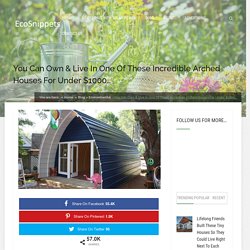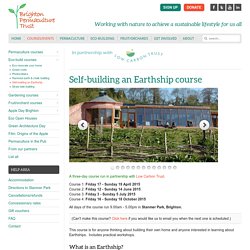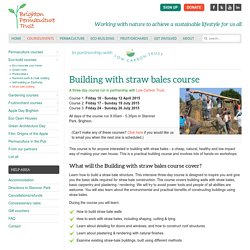

You Can Own & Live In One Of These Incredible Arched Houses For Under $1000… The sizing options that the company offers their customers is rather remarkable, but what is truly remarkable is the pricing.

You can buy an 8′ x 8′ unit for just $960.00 and with all the upgrades it is just $1352.00… Sizes range from the smaller 8′ x 8′ unit right up through to a massive 24′ x 40′ unit! The company will also deliver the arched home straight to your door and build it for you, wherever you want it to go! For the price, these are a steal! Just think of what you could do with one of these. There is even a trailer attachment option where they company will build an arched cabin directly onto a trailer so you are able to travel with your new pad… Check out the gorgeous interior of the 24′ x 32’… You can find out more about Arched Cabins here (via AwesomeJelly). If you like this idea, be sure to share it with your friends and inspire someone you know.
Cob house built for $250 from mud, straw and clay - no power tools used - HomeCrux. Off-grid-living Monitoring and Control Systems Exploration and Implementation. How To Build A €1000 Eco-Home In Just 100 Hours! Landblog/Houseblog. Swarms-- 16 May 2014 -- So the bees came through winter with many combs of honey in reserve.

I didn't harvest any of it because I wanted to make sure they would be ready to swarm this year so that I could do a split and have two hives. I figured it would take them a few months to build up their population enough to swarm, and some time in early May I would do an inspection and look for queen cells. If I found them, I would find the queen, move the queen and about half the combs into the #2 hive, keep all the combs with queen cells in the #1 hive, and also put some branches around the entrances to the #2 hive so the bees would re-orient and not go back to the #1 hive. So the bees feel like they've swarmed without actually swarming.
In late April, they swarmed. I could just barely touch the branch without falling off the ladder, so the best I could do was give it a shake, catch most of the bees in the bucket, carry them to the #2 hive, dump them in, and replace the bars on top. $300 Underground Greenhouse Grows Food Year Round; An Extraordinary Walipini. Posted Categories: Green From vertical farms to solar-powered “farms from a box,” we’ve seen how farming technology has grown leaps and bounds in recent years.

But for those who prefer something a little more rustic, growing food from a hole in the ground is as low-tech as you can get. A walipini, meaning “place of warmth” from the Amaraya Indian language, is an underground greenhouse with a transparent (usually plastic) covering that stays warm by passively soaking up the sun’s heat and absorbing the earth’s thermal energy. Fruits and vegetables can be grown year-round, making it ideal for communities in colder locations that can’t usually grow their own fresh and local produce during certain parts of the year. The farming method isn’t exactly new. The technique was notably adopted by The Benson Institute, a worldwide food security program of the Mormon church. The institute published a DIY manual on how to build such a structure. Ecological Land Co-operative.
We believe that the creation of sustainable rural livelihoods is one of the best solutions to our most pressing environmental and social problems.

Small-scale ecological production protects the environment and reduces greenhouse gas emissions by reducing fossil fuel use. Such businesses help build a vibrant, living countryside in which humans flourish alongside our cherished landscapes and natural biodiversity, and have a crucial role to play in ensuring food and energy security. They also provide employment, access to local, sustainable food and crafts and educational opportunities for urban visitors, helping to maintain rural skills and to improve ecological literacy. Such small scale enterprises also allow residents to be rooted in their rural locality, helping maintain and regenerate rural communities and the services upon which they depend such as local schools and shops. Hexayurt. LILI - home page. Welcome to. The Self Build Portal - The Gateway to more Self and Custom Build Homes.
Lets-build-our-own-apartments-in-london. Self-building an Earthship - Brighton Permaculture Trust. A three-day course run in partnership with Low Carbon Trust.

Course 1: Friday 17 - Sunday 19 April 2015 Course 2: Friday 12 - Sunday 14 June 2015 Course 3: Friday 3 - Sunday 5 July 2015 Course 4: Friday 16 - Sunday 18 October 2015 All days of the course run 9.00am - 5.00pm in Stanmer Park, Brighton. (Can't make this course? Click here if you would like us to email you when the next one is scheduled.) This course is for anyone thinking about building their own home and anyone interested in learning about Earthships. What is an Earthship? An Earthship is a low impact building that makes use of recycled materials in its construction including over 1000 car tyres. What will the Self building an Earthship course cover?
We will go through how a building can use the sun instead of central heating and how to build in natural, passive ventilation. Kevan Trott will discuss the practicalities of turning the dream into a reality: getting planning permission, building control and finances. Straw bale building - Brighton Permaculture Trust. A three-day course run in partnership with Low Carbon Trust.

Course 1: Friday 10 - Sunday 12 April 2015Course 2: Friday 17 - Sunday 19 July 2015Course 3: Friday 24 - Sunday 26 July 2015 All days of the course run 9.00am - 5.30pm in Stanmer Park, Brighton. (Can't make any of these courses? Click here if you would like us to email you when the next one is scheduled.) This course is for anyone interested in building with straw bales - a cheap, natural, healthy and low impact way of making your own house. One Couple's Brave Decision To Live Small Results In A Brilliantly Designed Home. A Right to Build by Alastair Parvin. WikiHouse.